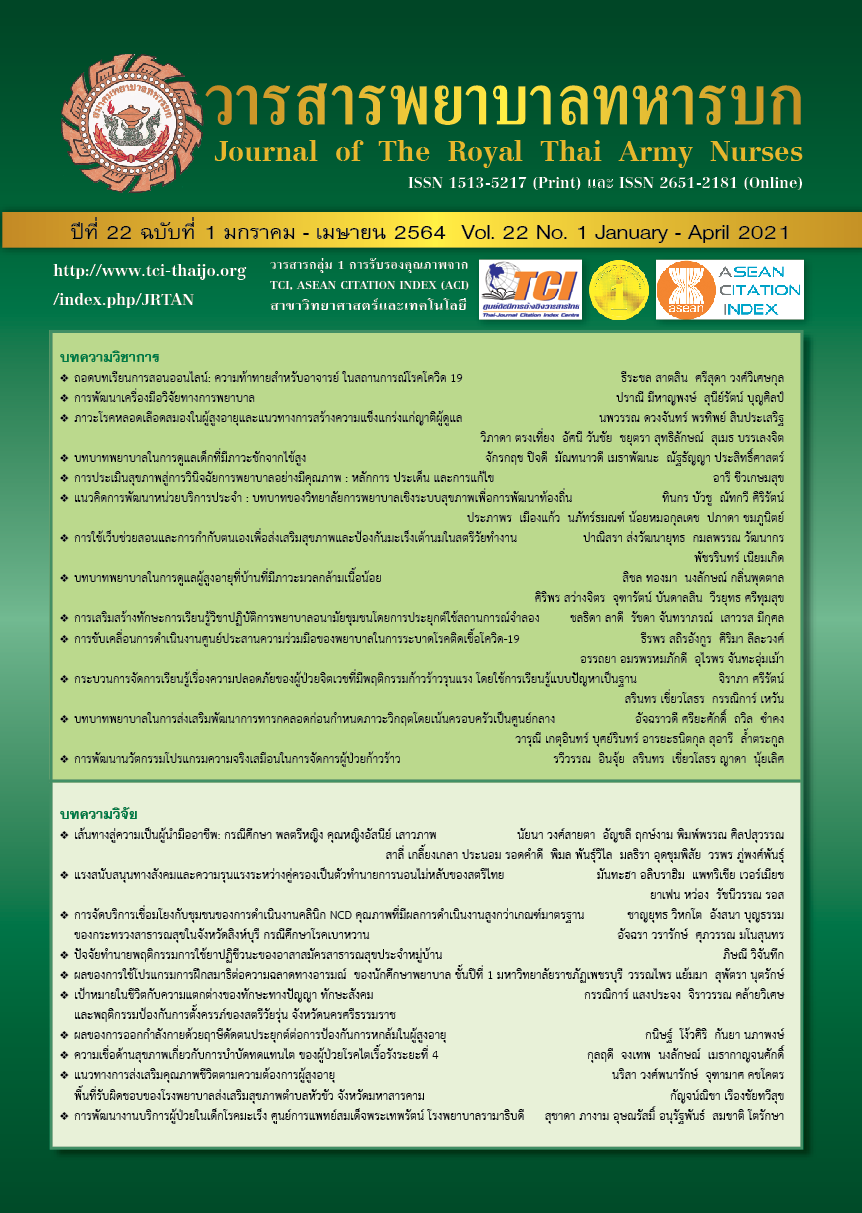Nurses’ Roles in Caring Children with Febrile Convulsion
Keywords:
Febrile convulsion, Nurses’ role, Caring childrenAbstract
Febrile convulsion is a common disease found in children at the age of 6 months – 5 years. Although the prognosis is rather effective, it makes caregivers feel much worried, and there will be several impacts in the case that children have recurrent seizures. Nurses have significant roles in utilizing the nursing process to do screening of children upon admission, involving in finding causes of fever, providing care for children during seizures, handling fever and preventing recurrent seizures, as well as preparing caregivers for fever handling at home and initial assistance for children in case of having febrile convulsion. Therefore, this article aims to present the data regarding febrile convulsion and role of nurses in providing care for children with febrile convulsion so that nurses acquire guidelines on planning and providing care for children with febrile convulsion efficiently, and that will further contribute to good quality of life of children and caregivers.
Downloads
References
Robert MK, Bonita FS, Joseph WG, Nina FS, Richard EB. Nelson textbook of pediatrics. 20th ed. Canada: Elsevier; 2016.
Phloenchaiwanit P. Risk factors of recurrent febrile seizure within 24 hours among hospitalized children. Thai Journal of Pediatrics. 2015; 54(4): 309-16. (in Thai)
Hockenberry MJ, Wilson D, Rodgers CC. Hockenberry: wong’s essentials of pediatric nursing. 10th ed. Canada: Elsevier; 2017.
Rebecca FI. Understanding the pathophysiology behind febrile convulsions. Nursing Standard. 2015; 27(2): 20-23.
Whelan H, Harmelink M, Chou E, Sallown D, Khan N, Patil R, et al. Complex febrile seizures-A systemic review. Disease-a-Month. 2017; 63: 5-23.
Byeon JH, Kim GH, Eun BL. Prevalence, incidence, and recurrence of febrile seizures in korean children based on national registry data. J Clin Neurol. 2018; 14(1): 43-47.
Piyakul N, Nammong J, Baouphol SS, Muangthong P. Quality of care management in children with febrile convulsion of a government hospital in Samutsakhon province. J Chulabhorn Royal Acad. 2020; 2(2): 50-64. (in Thai)
Leung AKC, Hon KL, Leung TNH. Febrile seizures: an overview. Drugs in Context. 2018; 7: 2125-2136.
Gillberg C, Lundstrom S, Fernell E, et al. Febrile seizures and epilepsy: association with autism and other neurodevelopmental disorders in the child and adolescent twin study in Sweden. Pediatr Neurol. 2017; 74: 8-16.
Bertelsen EN, Larsen JT, Petersen L, et al. Childhood epilepsy, febrile seizures, and subsequent risk of ADHD. Pediatrics. 2016; 138(2): 46-54.
Charoensatsiri R. Behaviors of parents in caring for children with febrile convulsion. J Prapokklao Hosp Clin Med Educat Center. 2018; 35(1): 40-46. (in Thai)
Barbi E, Marzuillo P, Neri E, Naviglio S, Krauss BS. Fever in children: pearls and pitfalls. Children. 2017; 81(4): 1-19.
American academy of pediatrics, steering committee on quality improvement and management, subcommittee on febrile seizures: Clinical practice guideline for the long-term management of the child with simple febrile seizures. Pediatrics. 2008; 121: 1281-1286.
Siriboriruk J. Pediatric febrile seizures. The Journal of Faculty of Nursing Burapha University. 2015; 23(4). 1-20. (in Thai)
Areewattananon S. Risk factors for recurrence of febrile seizures in children with first episode of febrile seizure at Nongkhai hospital. Mahasarakham Hospital Journal. 2016; 13: 119-28. (in Thai)
Duffy J, Weintraub E, Hambidge SJ, et al. Febrile seizure risk after vaccination in children 6 to 23 Months. Pediatrics. 2016; 138(1): 1-12.
Prasat Neurological Institute. Clinical practice guidelines for epilepsy. Bangkok: Tana Press; 2016. (in Thai)
Laino D, Mencaroni E, Esposito S. Management of pediatric febrile seizure. Int. J. Environ. Res. Public Health. 2018; 15: 1-8.
Gillberg C, Lundstrom S, Fernell E, et al. Febrile seizures and epilepsy: association with autism and other neurodevelopmental disorders in the child and cdolescent twin study in Sweden. Pediatr Neurol. 2017; 74: 80–6.
Bertelsen EN, Larsen JT, Petersen L, et al. Childhood epilepsy, febrile seizures, and subsequent risk of ADHD. Pediatrics. 2016; 138: 46-54.
Prapphal N, Shotelersuk V, Praisuwanna P. Deerojanawong V. editors. History taking and physical examination in pediatrics. Bangkok: Beyond enterprise; 2006. (in Thai)
Acliey BJ, Ladwig GB, Makic MBF. Nursing diagnosis handbook: an evidence–base guide to planning care. 11th ed. United States of America: Elsevier; 2017.
Phuphaibul R. editor. Nursing care plan for healthy and ill children. 2nd ed. Bangkok: Thammasapa; 2015. (in Thai)
Kyle T, Carman S. Pediatric nursing clinical guide. 2nd ed. China: Wolters Kluwer; 2017.
Paul SP, Kirkham EN, Shirt B. Recognition and management of febrile convulsion in children. Nursing Standard. 2015; 52(29): 36-43.
Monfries N, Goldman RD. Prophylactic antipyretics for prevention of febrile seizures following vaccination. Can Fam Physician. 2017; 63(2): 128-130.
Keebang J. The effects of parents participation program and capacity building parents in nasal irrigate on the child caring behaviors among parents of pre-school children with allergic respiratory diseases. Journal of The Royal Thai Army Nurses. 2019; 20(1): 236-244. (in Thai)
Downloads
Published
How to Cite
Issue
Section
License
บทความหรือข้อคิดเห็นใดใดที่ปรากฏในวารสารพยาบาลทหารบกเป็นวรรณกรรมของผู้เขียน ซึ่งบรรณาธิการหรือสมาคมพยาบาลทหารบก ไม่จำเป็นต้องเห็นด้วย
บทความที่ได้รับการตีพิมพ์เป็นลิขสิทธิ์ของวารสารพยาบาลทหารบก
The ideas and opinions expressed in the Journal of The Royal Thai Army Nurses are those of the authors and not necessarily those
of the editor or Royal Thai Army Nurses Association.






